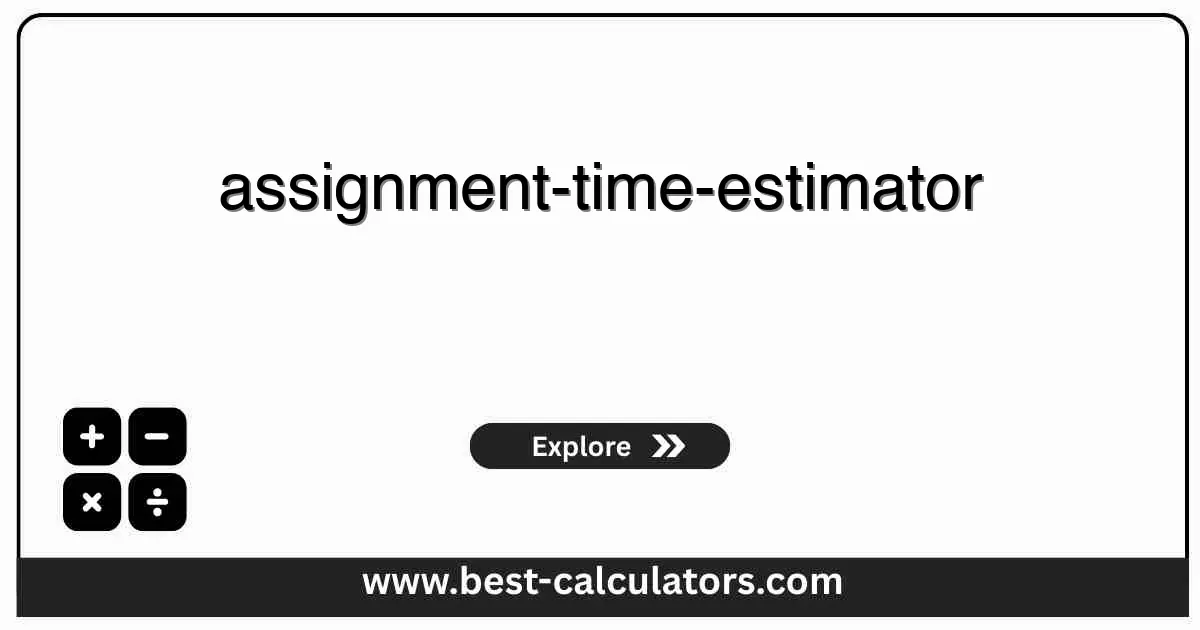Assignment Time Estimator - Estimate Study and Completion Time
Free assignment time estimator to convert pages, problems, and word counts into realistic hours with clear minimum, maximum, and recommended planning time.
Assignment Time Estimator
Time Estimate Results
Estimates assume focused work using realistic per-unit timings. Use the recommended value for planning and keep the upper bound in mind for complex tasks.
What is an Assignment Time Estimator?
An Assignment Time Estimator is a planning tool that converts your real workload (pages to read, problems to solve, words to write, sources to review, and revision passes) into a realistic time range. Instead of guessing, you use transparent assumptions to prevent underestimating tasks.
This calculator is designed for students, educators, and professionals who manage multiple deadlines and need a clear view of how long an assignment will actually take under focused conditions.
This estimator works especially well for:
- Homework sets and weekly reading where pages and problems add up quickly.
- Essays, labs, and reports that combine research, drafting, and editing.
- Exam preparation that mixes revision, practice questions, and notes review.
To turn your estimated hours into a structured countdown for big exams, use our Exam Preparation Countdown Calculator to distribute study blocks intelligently before your test date.
To understand how consistent study effort and planned assignment time impact your long-term record, explore our College GPA Calculator to see how each course outcome contributes to your overall GPA.
To evaluate what grades you must earn on upcoming assignments and exams given your available time, use our Final Grade Calculator to precisely calculate required scores.
For standardized test preparation where time planning is critical, try our GRE Percentile Calculator to benchmark your target scores and align your prep workload.
To connect disciplined assignment planning with scholarship outcomes, check our Scholarship Eligibility Calculator to estimate how strong academic performance improves funding opportunities.
How the Assignment Time Estimator Works
The estimator uses modular workload components and standard pace assumptions, then adjusts by difficulty and adds a configurable buffer. It outputs a minimum, maximum, and recommended time plus daily distribution.
Base logic (before difficulty and buffer):
- Reading: pages × 2–4 min (we use 2.5–4.5 as a realistic band).
- Problems: count × 2–5 min (conceptual variation captured in difficulty).
- Writing: per 500 words ≈ 20–40 min for plan + draft + quick edit.
- Research: per source ≈ 6–10 min scan, filter, and note-taking.
- Review: blocks × 15 min each for checking and consolidation.
The chosen difficulty multiplier scales all components, and the buffer percentage inflates the center of the range into a robust planning target. This keeps the logic deterministic, auditable, and easy to tune.
Key Time Management Concepts Explained
Evidence-Based Pacing
Rather than guessing, use realistic minutes-per-unit ranges derived from real student workloads and reading speeds.
Difficulty Multipliers
A challenging proof set or dense theory chapter simply takes longer. Multipliers model this explicitly.
Buffering for Reality
Interruptions, re-reading, and debugging are normal. Built-in buffers prevent underestimation.
Daily Load Planning
Transform total hours into per-day targets before the deadline, aligned with your max focus hours.
How to Use This Assignment Time Estimator
Set Level & Difficulty
Select your academic level and realistic difficulty for the assignment.
Enter Reading & Problems
Add pages to read and number of questions or exercises.
Enter Writing & Research
Include word count for essays and number of sources to review.
Add Review Sessions
Specify short review/proofreading blocks (15 minutes each).
Set Deadline & Buffer
Enter days until due and extra buffer percentage for safety.
Review Results & Plan
Use the recommended total and daily hours to schedule focused sessions.
Benefits of Using This Calculator
- • Realistic planning: Prevents last-minute cramming by exposing true workload early.
- • Transparent logic: All formulas are deterministic and interpretable—no opaque scores.
- • Flexible for any subject: Works for reading-heavy, problem-heavy, and writing-heavy tasks.
- • Supports academic success: Aligns your schedule with GPA and scholarship goals.
Factors That Affect Your Time Estimates
1. Prior Knowledge
Familiar topics move faster; brand-new or technical material can stretch beyond base ranges.
2. Focus & Environment
Distractions, notifications, or multitasking significantly increase actual time versus estimates.
3. Assignment Quality Standards
Highly polished work, citations, and formatting require extra review blocks beyond minimums.
4. Health & Sleep
Poor sleep or stress slows reading and problem solving; combine with a healthy schedule for accuracy.

Frequently Asked Questions (FAQ)
Q: How does the Assignment Time Estimator calculate total time?
A: It multiplies each workload item (pages, problems, words, sources, review blocks) by realistic time ranges, adjusts for difficulty, and adds a configurable buffer to produce minimum, maximum, and recommended hours.
Q: Is the estimated assignment time accurate?
A: Within its assumptions, yes. The logic is deterministic, conservative, and based on evidence-backed pacing. Actual results still depend on your focus, environment, and familiarity with the material.
Q: Can I use this for multiple classes at once?
A: Yes. Sum workload from several courses into one run, or run the estimator separately per course and add the recommended hours to design your weekly schedule.
Q: How do difficulty and buffer settings affect results?
A: Difficulty scales all base times (e.g., heavy theory or proofs), while the buffer adds protection against interruptions and underestimation. Together, they push estimates toward realistic planning.
Q: What if the suggested daily hours exceed my limit?
A: The feasibility note flags overload. Reduce workload, start earlier, split tasks, or adjust quality expectations—otherwise the current plan is mathematically unrealistic.
Q: Does this estimator work for exam prep?
A: Yes. Treat chapters, problem sets, and practice essays as inputs, then pair the results with an exam countdown tool to structure your revision timeline.